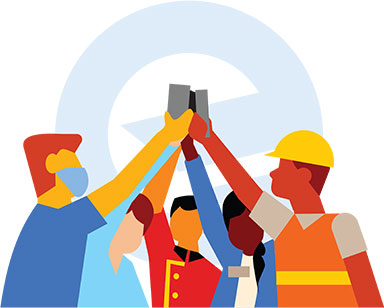For far too long, synchronous communication has been the only way to reliably share a message with deskless and hourly workers.
Synchronous communication is defined as communication that must be sent and received at the same time: it insists that information is exchanged in real-time, with both the sender and the receiver being available at the same moment.
In the workplace, especially outside of the office environment, here’s what synchronous communication has looked like for decades (ok, maybe even centuries):
- If a manager needed to find a team member to work overtime, he either asked them while they were at work, or called them at home.
- If an announcement needed to go out to the company, an all-hands meeting was required.
- If a procedure changed, every employee had to be told, showed, and trained on the new procedure, most likely in-person. This was repeated for each shift/group as well as for any absent employees.
- If an employee had a question, she spoke to her manager in person or on the phone, interrupting whatever the manager (and the employee) was currently doing.
- If an employee needed to reach Human Resources, he made an appointment with the HR Manager or stopped by the HR office on his way out the door.
All of these scenarios require at least one person to be interrupted.
These everyday communications cause disruptions and disturbances, which decrease productivity and create frustration. That said, the cause of these interruptions are not unimportant questions or communications – on the contrary, they are critical for employees, managers, and your organization as a whole. They cannot be dismissed or minimized, but they can be handled in a more effective way that creates engagement, builds trust, and helps everyone find separation between work and home life.
If you’re looking for evidence that this can be a game-changer, consider this question: do you remember the transition that text messaging and email brought to your life? Instead of answering every phone call for fear of missing a critical message (which was almost never the case), you were able to receive and send communications on your own terms.
Asynchronous communication was ushered into the office through email (ok, ok, snail mail and memos were O.G. async, but emails really changed the game). There’s a ton of online chatter right now related to how we’ve ruined email by treating it as synchronous communication. If you ever feel like you need to respond to an email within 5 minutes, you know what I am talking about. You can read more about async for the knowledge worker here, here, and here. But that’s not our primary topic of discussion in this post.
Instead, let’s take a closer look at how asynchronous communications can change the game for the hourly and deskless workers.
If your team members are engaging directly with patients, working on an assembly line, building a house, stocking a shelf, or bartending, synchronous communication can be a massive interruption. Whether you’re at work or at home, synchronous communication puts demands on your time – and it has no regard for your schedule or obligations.
Imagine you are a non-desk employee. Getting pulled into synchronous communication while you’re working can cost you tips, or even worse, it can cause an accident. If your manager pulls you aside to tell you something while you’re in the middle of a complex process, it can compromise the quality of your work.
Until recently, employees who work outside of an office setting have been extremely limited in how they’re able to receive asynchronous communication. Work email still excludes more than half of the working world, and flyers, posters, digital signage, and intranets simply aren’t effective in reaching more than 30% of your workforce. Why?
One of the biggest reasons is simple (and it’s the same reason your teenager won’t make eye contact with you at dinner) – everyone’s looking at their phones all the time. Furthermore, these more formal methods of creating, posting, and publishing information require copious amounts of time and effort to maintain. Lastly, generic blasts of information are often irrelevant, rarely personal, and frequently ignored.
Nearly every other piece of asynchronous communication that you receive in everyday life is accessible on your mobile phone – why should work communications be any different?
Much of the conversation around asynchronous communication centers on reclaiming your time. We think non-desk workers deserve to have more ownership of their time too. By moving away from a reliance on synchronous communication, your team members can be more informed and productive with fewer interruptions.
So, what does asynchronous communication look like on the plant floor, in a casino, or on a construction site? And what are the advantages? Here are 6 key benefits of leveraging a mobile asynchronous communication platform for your deskless workforce:
- Relevant – Targeted group messages ensure that employees receive only the messages that are relevant to them. By reducing the volume of all communication, you raise the importance of the communications that your employees do receive.
- Accessible – Written messages delivered electronically reach ALL team members, including those who are absent, on vacation, hearing impaired, or working a different shift. Every employee may not be accessible at the time the message is sent, but they will receive and consume the message at a time when they are available.
- Reviewable – Asynchronous communications are written communications, which means they can be read and re-read. This is often helpful when digesting complex information. Additionally, having the ability to reference older messages prevents future interruptions and makes work more efficient.
- ‘On your time’ – Employees are no longer facing intrusive phone calls at home. They can check work messages and review open shifts at their discretion, and they know that missing a phone call from work so they can have dinner with their family won’t cost them an opportunity to work overtime.
- ‘On your terms’ – ‘Do Not Disturb’ and notification preferences enable employees to manage when they are notified about work. This helps create boundaries, while enabling employees to check in on their own time, on their own terms.
- Accountable – Read receipts help managers know who has or has not received a message. This drives accountability and can help managers follow up strategically with key employees to ensure they are in the loop, without interrupting all team members a second time.
Asynchronous communication at its best provides employees with more autonomy and respect.
As many desk-based organizations move away from synchronous communication to lessen burnout and reduce Zoom fatigue, we want to help organizations extend the same benefit to their employees who are not tethered to a computer. Whether you work on a construction site, behind a bar, or on an assembly line, your best work (and life) happens when you have fewer interruptions and more control over your day.


